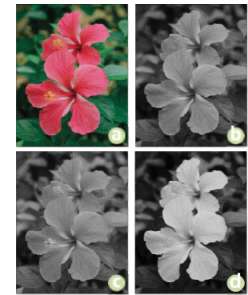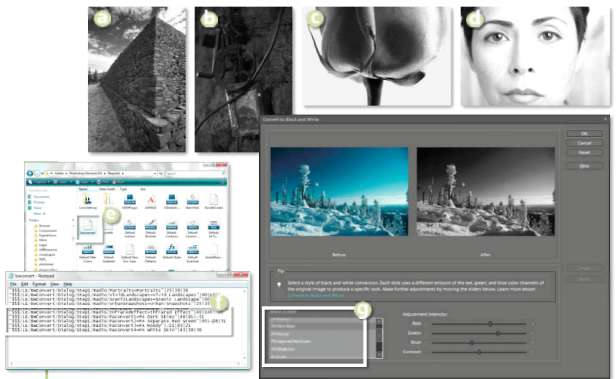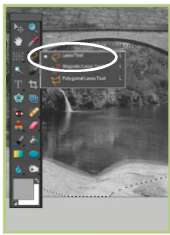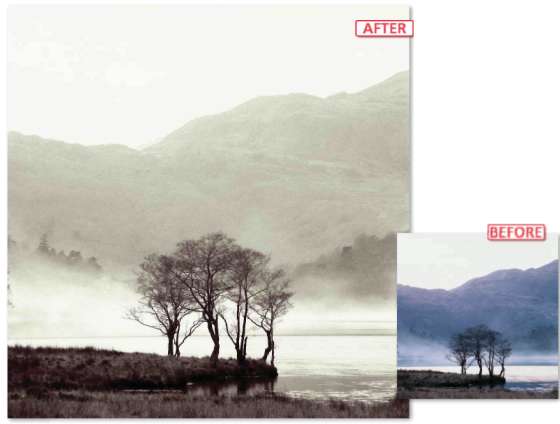6 Image Changes – Beyond the Basics
Advanced selection techniques
Many great image editing techniques are based on the ‘selection’ prowess of the photographer. Being able to manipulate the selection tools to isolate the precise pixels that you wish to edit is a key skill that we all should possess. The following techniques will help you build on your existing selection skills.
6.01 Adding to and subtracting from selections
Suitable for Elements – 7.0, 6.0, 5.0, 4.0, 3.0, 2.0, 1.0 | Difficulty level – Basic Related techniques – 6.02, 6.03, 6.04, 6.05 | Tools used – Magic Wand, Lasso, Marquee
Only on a very rare occasion will you be able to create the perfect selection with a single tool applied once. Most editing jobs require the building of selections using multiple tools, creating new selections that are either added to, or subtracted from, existing selections. Photoshop Elements provides a range of features that are designed for just this purpose.
When a selection tool is in use four selection modes are available in the options bar. By switching between these modes while making additional selections you can:
• Create a new selection each time the tool is applied,
• Add to an existing selection,
• Subtract from an existing selection, or
• Make a selection from the intersection of the new and old selections.

Adding to selections>> Modify your selections by switching selection modes using the buttons found in the Options menu. (a) New selection. (b) Add to selection. (c) Subtract from selection. (d) Make new selection from the intersection.
The modes are available for all selection tools the exception being that the Intersect mode can not be used with the Quick Selection Tool or the Selection Brush tools. The New Selection option is tne default. Complex areas ol a picture can be isolated by making a series ol selections choosing the necessary tool (Lasso, Marquee, Magic Wand, Selection Brush or Quick Selection Tool) and mode (new, add to, subtract from, intersection of) as you go. The mode of the current tool can also be changed using a keyboard shortcut whilst selecting. Hold down the Shift key to add to a selection or the Alt key to take away or subtract from a selection.
6.02 Using the Selection Brush
Suitable for Elements – 7.0, 6.0, 5.0, 4.0, 3.0, 2.0 | Difficulty level – Intermediate | Resources – Web image 602 Related techniques – 6.01, 6.03, 6.04, 6.05 | Tools used – Selection tools | Menus used – Select
Responding to photographers’ demands for even more options for making selections, Adobe included the Selection Brush for the first time in version 2.0 of Elements. The tool lets you paint a selection onto your image. The size, shape and edge softness of the selection are based on the brush properties you currently have set. These can be altered in the Brush Presets pop-up palette located in the options bar.
The tool can be used in two modes – Selection and Mask:
• The Selection mode is used to paint over the area you wish to select.
• The Mask mode is particularly well suited for showing the soft or feathered edge selections made when painting with a soft-edged brush or when making detailed edits to the selection. The Mask mode works by reverse painting in the areas you want to ‘mask from the selection’.
Holding down the Alt (Windows) or Option (Mac) keys whilst dragging the brush switches the tool from adding to the selection to taking away from the area.

Painting selections >> The Selection Brush tool allows the user to create selections by painting directly onto the picture surface.

Selection Brush modes >> The Selection Brush can work in either selection or mask modes.
6.03 The Quick Selection Tool
Suitable for Elements – 7.0, 6.0 , 5.0, 4.0, 3.0, 2.0 | Difficulty level – Intermediate | Resources – Web image 6.02 Related techniques – 6.01, 6.03, 6.04, 6.05 | Tools used – Selection tools | Menus used – Select
Along with the Selection Brush tool, the new Quick Selection tool (previously the Magic Selection Brush) provides Elements users with a unique approach to creating and modifying selections. As we have seen, when using the Selection Brush the user must paint over the area to be encompassed by the selection. The accuracy of this painting step determines the accuracy o the final selection. For example, accidentally painting over an edge will result in the creation of a selection that goes beyond this picture part.

Quick ‘magical’ selections >> The Quick Selection tool is coupled with the Selection Brush in the tool bar.
The Quick Selection tool provides a quicker, easier and, in most cases, more accurate way to make selections by combining both the drawing and color selection approaches of the other tools we have covered. To make a selection choose the tool from the tool bar. If it is hidden from view click the small arrow at the bottom right of the Selection Brush button to reveal the tool. The Quick Selection tool doesn’t require you to scribble or place some dots on the picture parts that you want to select as was the case with the Magic Selection Brush. Instead Elements creates the selection as you paint over specific picture areas. You don’t have to be too careful with your initial painting as the program registers the color, tone and texture of the picture parts and then intelligently searches for other similar pixels to include in the selection.

Elements does the selection work >> As you are drawing with the Quick Selection tool Elements automatically generates a selection of all the adjacent areas in the picture that have similar color, texture or tone.
Fine-tuning the areas selected with Quick Selection tool
Although this tool does a pretty good job of selecting alike areas, there will always be occasions when either too much or too little of the picture has been included. Just like the other tools we have looked at, the Quick Selection tool allows you to easily modify the selections it makes.
To include other areas in the selection, click the Add to Selection button in the tool’s options bar (the cursor will change to include a small +) and paint over a new picture part. This step will cause Elements to regenerate the selection to include your changes. To remove an area from the selection, click on the Subtract from Selection button (cursor changes to the brush tip and a small – sign), and paint over the part to eliminate. Again, Elements will regenerate the selection to account for the changes. The Shift and Alt keys can be used whilst drawing to change modes on the fly and add to or subtract from the selection.

Adding to or subtracting from quick selections>> The options bar of the Quick Selection tool contains several modes that can be used for altering or refining the selection created by the tool. You can add other picture parts to a selection by clicking on the Add to Selection button and then painting over the new area. Parts already selected can be removed by changing to the Subtract from Selection mode and painting on these areas.
6.04 Advanced refining of selection edges
Suitable for Elements – 7.0, 6.0, 5.0, 4.0, 3.0, 2.0 | Difficulty level – Intermediate | Resources – Web image 602 Related techniques – 6.01, 6.03, 6.04, 6.05 | Tools used – Selection tools | Menus used – Select
Photoshop Elements also contains a way to modify the edges of the selections you create. Called the Refine Edge feature it is accessed either via the button now present in all the selection tools’ options bars, or via the Select > Refine Edge menu entry. The feature brings together three different controls for adjusting the edges of the selection with two selection edge preview options. The edge controls previously existed as separate entries in either the Select or Select > Modify menu. Bringing them together in the one dialog, and then providing live preview options as well, means that the refining activity will be a lot more accurate, as you will be able to see the results of the changes made to any of the controls reflected in the image itself.
The feature’s dialog contains a Preview toggle, and Zoom and Move tools which can be used for navigating around enlarged images to check the properties of the selection edge. The edge controls themselves come in the form of the following three sliders:
Smooth – This option removes stepped or jagged selection edges.
Feather – Softens the edge of the selection by a given pixel value. You can use this setting to provide a gradual transition between selected and non-selected areas.
Contract/Expand – Increase or decrease the size of the area outlined by the selection by the percentage value selected.

Preview Modes >> The Quick Selection tool contains two preview modes. The standard option (left) shows the traditional marching ants outlining the selected area and the Mask view (right) displays a colored mask over the non-selected areas.

Refine Edges dialog >> The Refine Edge dialog brings together all the controls used for altering the characteristics of the selection’s edge into a single dialog. The feature also includes two edge preview options.
The Preview modes buttons at the bottom of the dialog provide a range of different ways to view the selection on your picture. The left button displays a standard selection edge superimposed on the photo. The edge is outlined using the familiar ‘marching ants’ line.
The other button previews the selection as a mask, with the selected area displayed clear of color and the non-selected area colored with a specific color overlay. The color and transparency of the mask overlay can be altered by double-clicking the preview button.
Selecting the Mask option provides a much better way of viewing the quality of the selection edge as it is possible to preview the sharpness of the edge as well as how transparent the overlap is between selected and non-selected areas (feathering). For best results, use the Mask option in conjunction with the Zoom and Move tools to inspect an enlarged preview of the selection edge, as you make changes to the dialog’s slider controls.
Press the ‘P’ key to turn off the preview of the current Refine Edge settings and the ‘X’ key to temporarily display the Full Image view.

Overlay options >> By double-clicking the Mask Preview option you can alter the color and opacity of the mask.
6.05 Saving and loading selections
Suitable for Elements – 7.0, 6.0, 5.0, 4.0, 3.0, 2.0, 1.0 | Difficulty level – Intermediate | Resources – Web image 6.04 Related techniques – 6.01, 6.03, 6.04, 6.05 | Tools used – Selection tools | Menus used – Select
Photoshop Elements thankfully gives you the option to save all your hard selecting work so that it can be used again later. With your selection active choose the Save Selection option from the Select menu. Your selection will now be saved as part of the file when you save in PSD, TIFF, PDF or JPEG 2000 formats. When you open the file later you can retrieve the selection by choosing Load Selection from the same menu. This feature is particularly useful when making sophisticated multi-step selections, as you can make sequential saves, marking your progress and ensuring that you never lose your work. The Save Selection dialog also provides you with another way to modify your selections. Here you will find the option to save a newly created selection in any of the four selection modes we looked at earlier. This provides you with an alternative method for building complex selections which is based on making a selection and then saving it as an addition. In this way you can create a sophisticated selection one step at a time.

Save Selection dialog >> You can also choose to modify your selection via the modes in the Save Selection dialog.

Step 1 >> Use your favorite tool to make your first selection.

Step 2 >> Save this as a new selection using the Select > Save Selection feature. Deselect (Ctrl + D).
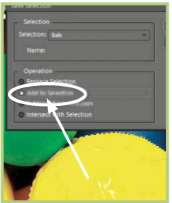
Step 2 >> Make a new selection and then save it using the Add to Selection mode in the Save dialog.
6.06 Modifying selections
Suitable for Elements – 7.0, 6.0, 5.0, 4.0, 3.0, 2.0, 1.0 | Difficulty level – Intermediate | Resources – Web image 6.04 Related techniques – 6.01, 6.02, 6.04 | Tools used – Selection tools | Menus used – Select
Apart from adding to and subtracting from selections, Photoshop Elements also offers several other ways to modify your selections. We have already seen some of these options in the Refine Edge feature. Here we look at them individually . Nested under the Select menu, most of these options change the positioning or character of the selection’s edge. They can provide quick ways to adjust your selections. Use Refine Edge if you want to preview the changes to the selection before application.
• Select > Feather adjusts the smoothness of the transition between selected and non-selected areas. Low values are used for sharp-edged selections and higher values for softer ones.
• Select > Modify > Border creates a border of a specific pixel width at the selection’s edge. Add color to this border using the Edit>Fill command. This option only creates soft edge borders. Use Edit>Stroke to create hard-edged lines around a selection.
• Select > Modify > Smooth searches for unselected pixels within the nominated radius. If these areas are surrounded by selected pixels then they will be included in the selection; if the surrounding areas are not selected then they will be removed from the selection.
• Select > Modify > Expand increases the size of the selection evenly by the pixel amount selected.
• Select > Modify > Contract decreases the selection size by the pixel amount selected.
• Select > Grow selects pixels adjacent to the selection that are within the tolerance range of the Magic Wand settings.
• Select > Similar chooses all pixels throughout the picture that fall within the Magic Wand tolerance settings.

Feather >> Use this option to create graduated edges to your selections.
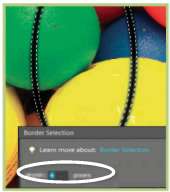
Border >> This option creates a soft-edged border, a specific number of pixels wide.

Smooth >> Use this option to include random unselected pixels in an otherwise selected area.
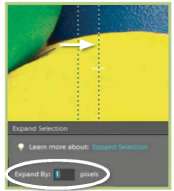
Expand >> Increase a selection’s size by a given number of pixels with this command.
Contract >> Reduce the size of the selection by a given number of pixels with this setting.

Grow >> Use this option to select all adjacent pixels that fall within the current Magic Wand settings.

Similar >> This command selects all other pixels in the whole image that fall within the Magic Wand settings.
6.07 Transforming a selection
Suitable for Elements – 7.0, 6.0, 5.0, 4.0, 3.0, 2.0, 1.0 | Difficulty level – Intermediate | Resources – Web image 606 Related techniques – 6.01, 6.02, 6.03, 6.05 | Tools used – Selection tools | Menus used – Image
By combining the abilities of the transformation tools that Photoshop Elements provides with several selection techniques you have the power to seamlessly change the way that your pictures look. The features grouped under the Transform heading include tools that can alter the scale and rotation of your picture as well as those that can be used to skew, distort or apply perspective to the image. These changes can be made to the photograph as a whole, to the contents of a layer, to a selection or to a shape that you have drawn. Not all transformation options are available in all situations. For example, the Distort & Perspective options cannot be applied to the contents of a text layer.

Select, copy and paste >> By manipulating selected parts of your picture you can change a straight image into something that on the one hand is obviously not real, but because it has been so seamlessly altered, it has an aspect of believability Here the eyes and mouth of the subject have been selected, copied and enlarged before being blended back into the original picture.
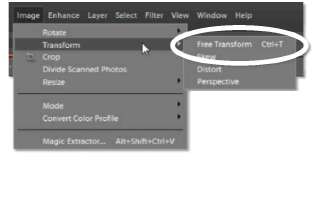
Transform >> The Free Transform tool provides a fast and effective way to manipulate the size and shape of your pictures.
When a transformation tool is active the image area will be surrounded by a ‘bounding box’ containing several adjustment handles at its corners and sides. By dragging these handles you will be able to manipulate the picture. Most experienced image editors use the Free Transform tool (Image > Transform > Free Transform) for all their transformation changes. With this one feature and a few different keyboard combinations you can perform all your image adjustments without selecting another feature. Use the guide below to help you use the Free Transform tool:
• To scale – drag on one of the corner handles of the bounding box.
• To scale from the center – press the Alt key whilst dragging a corner handle.
• To maintain aspect ratio whilst scaling – hold down the Shift key whilst dragging.
• To rotate – move the cursor outside the bounding box until it changes to a curved two-ended arrow, then click and drag to rotate the picture or drag the Rotate handle at the bottom of the bounding box.
• To distort – hold down the Ctrl key whilst dragging any handle.
• To skew – hold down the Ctrl + Shift keys whilst dragging a side handle.
• To apply a perspective change – hold down Ctrl + Alt + Shift whilst dragging a corner handle.
• To commit changes – double-click inside the bounding box or hit Enter, or click the Commit icon (green tick) at the bottom of the marquee.
In the example the exaggerated eyes and mouth were created by firstly selecting the face parts, feathering the edge of the selection (Select > Feather) and then copying (Edit > Copy) and pasting (Edit > Paste) each part onto a new layer. With the appropriate layer selected the parts were then enlarged using the Free Transform feature (Image > Transform > Free Transform) and distorted a little (Image > Transform > Distort) to suit the rest of the face. As a final step a soft-edged eraser was used to remove sections of the face parts that didn’t match the picture below. This step helped to blend changes into the original image.
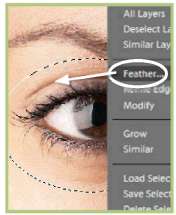
Step 1 >> Copy and paste onto new layers parts of the picture that were selected using a feather.

Step 2 >> Change the size of the face parts and apply some distortion using the Free Transform tool. Double-click inside the bounding box to commit your changes.
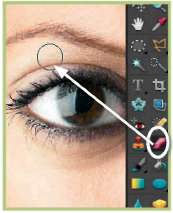
Step 3 >> Carefully erase the edge of the transformed face parts to blend them with the rest of the original image below.
6.08 Precise control of selection size
Suitable for Elements – 7.0, 6.0, 5.0, 4.0, 3.0, 2.0, 1.0 | Difficulty level – Intermediate | Related techniques – 6.01, 6.02, 6.03, 6.04
Tools used – Marquee | Menus used – Window, Edit, View
There will be times when you will need to know the precise size of the selections you make. You can get this information from the Info palette (Window > Info) where Elements reports the width and height of your selection in the units selected in the Units preferences (Edit > Preferences > Units and Rulers). This dialog also shows the exact position of the cursor. This can be helpful when you need to start and end a selection at a set screen reference.
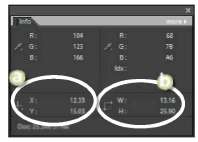
Info >> The Info palette shows the position of the cursor (a) as well as the size of the selection (b).

Fixed Size selections >> Make precise selections by inserting the dimensions directly into the Marquee’s option bar.
If instead of just viewing the dimensions of the selection you actually want to specify the size, you can input these values into the options bar of the Marquee tool. After selecting the tool, choose Fixed Size from the Style drop-down menu in the Options bar. You can then enter the value for width and height into the fields in the bar. Now when you click on the canvas with the Marquee tool, a selection of the precise dimensions you input will appear on the picture. As with the Info dialog the measurement units used here are controlled by the settings in the Units and Rulers preferences.
Another way to precisely control the size of your selections is to use the Elements Grid system as a guide. Simply display the Grid over your picture (View >Snap To > Grid) and switch on the Snap to Grid option (View > Snap to Grid). Now as you are drawing a selection the cursor will align itself with the grid lines or intersections. The interval of the grid lines and spacings can be altered via the Grid preferences (Edit > Preferences > Grid).

Grid as guide >> Use the Elements Grid option to help make precise selection. Image courtesy of www.darranleal.com.au .
Understanding layers
In a lot of ways traditional film-based shooting is very similar to digital photography. After all, apart from a few useful additions such as a preview screen on the back and a slot for my memory card, my digital camera is not unlike my film camera (in fact they even share the same lenses). But thinking that these similarities extend to the pictures themselves can mean that you are missing out on some of the more powerful capabilities of your digital pictures.
Digital pictures are not always flat
The traditional photograph contains all the picture elements in a single plane. Digital images captured by a camera or sourced from a scanner are also flat files. And for a lot of new digital photographers this is how their files remain – flat. All editing and enhancing work is conducted on the original picture, but things can be different.
Most image editing packages contain the ability to use layers with your pictures. This feature releases your images from having to keep all their information in a flat file. Different image parts, added text and certain enhancement tasks can all be kept on separate layers. The layers are kept in a stack and the image you see on screen in the work area is a composite of all the layers.
Sound confusing? Well try imagining for example that each of the image parts of a simple portrait photograph are stored on separate plastic sheets. These are your layers. The background sits at the bottom. The portrait is laid on top of the background and the text is placed on top. When viewed from above the solid part of each layer obscures the picture beneath. Whilst the picture parts are based on separate layers they can be moved, edited or enhanced independently of each other. If they are saved using a file format like Photoshop’s PSD file (which is layer friendly) all the layers will be preserved and present next time the file is opened.

Layers >> A digital picture is often composed of many parts, each stored on a separate layer. Image courtesy of www.ablestock.com © 2005.
Types of layers
Image layers: This is the most basic and common layer type, containing any picture parts or image details. Background is a special type of image layer.
Text layers: Designed solely for text, these layers allow the user to edit and enhance the text after the layer has been made.
Fill layers: Users can also apply a Solid Color, Gradient or Pattern to an image as a separate layer.
Adjustment layers: These layers alter the layers that are arranged below them in the stack. They act as a filter through which the lower layers are viewed. You can use adjustment layers to perform many of the enhancement tasks that you would normally apply directly to an image layer without changing the image itself. Adjustment layers are added automatically when using the Smart Brush Tool.
Shape layers: Drawing with any of the shape tools creates a new vector-based Shape layer. The layer contains a thumbnail for the shape as well as the color of the layer.
Frame layers: From Elements 5.0 Adobe has included a new layer type to coincide with its Photo Layout and Photo Book projects. Called the Frame layer, its role is to store both the frame and the picture that sits within it. Both the component parts remain as separate individual images despite being stored as one layer. What does this mean in day-to-day editing? Well it means that you can do things like change the size, shape and orientation of either the frame and picture combination, or the picture, independently of each other.
Background layers: An image can only have one background layer. It is the bottom-most layer in the stack. No other layers can be moved beneath this layer. You cannot adjust this layer’s opacity or its blending mode. You can convert background layers to standard image layer’s by double-clicking the layer in the Layers palette, setting your desired layer options in the dialog provided and then clicking OK.
The magic of Frame layers
Adobe introduced Frame layers as part of its revamp of Photo Project creation in version 5.0. For most Elements users, frame layers are seen as a way to add decorative edges to their photos when creating albums or scrapbooking pages, but their quiet power goes beyond mere framing. Frame layers are built on a Photoshop Technology called Smart Objects.

Non-destructive resizing with Frame layers >> To give you an example of how destructive seemingly small changes to our image layers are I resized a standard image layer up and down three times. It is easy to see how blurry the photo has become (a). Next I added the same picture to a frame layer and performed exactly the same resizing activity. The result is an image as sharp as the original (b).
Professionals in the know use Smart Objects as a way of protecting their photos from the damage associated with resizing, rotating and distorting image layers. A smart object keeps the pixels safe by applying the changes made to the layer to a copy of the pixels rather than the original photo.
It may not be immediately apparent when you are first playing with your images in this way, but each time you make a change to the size or orientation of your photo the pixels are resampled. This means that the original pixels are being changed with each adjustment, and you know how I feel about that! Perform enough of these changes and gradually the image becomes less and less defined. See the example images on the right. How can we avoid this degradation? Well, one way to ensure that your files remain as crisp as the day that they were taken is to add the image to a frame layer before messing around with size and rotation. Don’t want a frame around the photo? No problem just add the ‘No Frame’ frame layer to your document and then drag the picture from the project bin to the No Frame area in the composition. You can also simply drag a photo from the project bin onto an open document; it is added automatically as a Frame layer. Alternatively you can right-click on a framed photo and choose Clear Frame from the context menu.

No Frame frame layer >> To gain the abilities of a frame layer without the frame, select the No Frame option from the Frames section of the Content palette.
Now you can free transform to your heart’s content without the fear of resampling, and therefore damaging, the pixels.

Layer types >> (a) Text or type layer, (b) images layer with chequered transparent area, (c) background layer, (d) Layers palette, (e) preview window with separate layers viewed as a composite image.
Adding layers
When a picture is first downloaded from your digital camera or imported into Photoshop Elements it usually contains a single layer. It is a ‘flat file’. By default the program classifies the picture as a background layer. You can add extra ‘empty’ layers to your picture by clicking the New Layer button at the bottom of the Layers palette or choosing the Layer option from the New sub-menu in the Layer menu (Layer > New > Layer). The new layer is positioned above your currently selected layer. Some actions, such as adding text with the Type tool, automatically create a new layer for the content. This is true when adding adjustment and fill layers to your image. When selecting, copying and pasting image parts, Photoshop also creates a new layer for the copied portion of the picture. Also when you use the Background eraser or the Magic Eraser, a new layer will automatically be created.
Viewing layers
Photoshop Elements’s Layers palette displays all you r layers and their settings in the one palette. If the palette isn’t already on screen when opening the program, it may be hidden in the Palette Bin or you may have to choose the option from the Window menu (Window > Layers). The individual layers are displayed, one on top of the other, in a ‘layer stack’. The image is viewed from the top down through the layers. When looking at the picture on screen we see a preview of how the image looks when all the layers are combined. Each layer is represented by a thumbnail on the left and a name on the right. The size of the thumbnail can be changed, as can the name of the layer. By default each new layer is named sequentially (layer 1, layer 2, layer 3). This is fine when your image contains a few different picture parts, but for more complex illustrations it is helpful to rename the layers with titles that help to remind you of their content (portrait, sky, tree).

Visible layers >> When the Eye icon is present the layer is visible. Clicking on the eye turns the icon off, removing the layer from the preview window.
You can edit or enhance only one layer at a time. To select the layer that you want to change you need to click on the layer. At this point the layer will change to a different color from the rest in the stack. This layer is now the selected layer and can be edited in isolation from the others that make up the picture. Layers can be turned off by clicking the eye symbol on the far left of the layer so that it is no longer showing. This action removes the layer from view but not from the stack. You can turn the layer back on again by clicking the space where the eye symbol was. Holding down the Alt key whilst clicking on a layer’s eye symbol will turn off or hide all layers other than the one that you are clicking.
Manipulating layers
Layers can be moved up and down the layer stack by click-dragging. Moving a layer upwards will mean that its picture content may obscure more of the details in the layers below. Moving downwards progressively positions the layer’s details further behind the picture parts of the layers above.
You can reposition the content of any layers (except background layers) using the Move tool. Two or more layers can be linked together so that when the content of one layer is moved the other details follow precisely. Simply multi-select the layers in the Layers palette and then click on the Chain icon (Link Layers button) at the top of the palette. The chain will be added to all the linked layers on the right of the thumbnail. Unwanted layers can be deleted by click-dragging them to the Dustbin icon at the top of the Layers palette.
Layer styles
In early image editing programs creating a drop shadow edge to a picture was a process that involved many steps. Thankfully Elements includes this as one of the many built-in styles that can be quickly and easily applied to your layers. Users can add effects by clicking on the Effects palette tab in the Palettes pane and selecting a layer style from those listed in the Layer Styles section. You can edit the style settings by double-clicking on the small ‘fx’ icon on the right of the thumbnail in the Layers palette.

Blending modes >> Changing the blending mode of upper layers will cause them to interact differently with the layers beneath. The example above shows how altering the blending mode of the text layer changes the way that it interacts with the image and background layers. (a) Normal mode. (b) Color Burn mode. (c) Difference mode. (d) Overlay mode. (e) Luminosity mode. (f) Color Dodge mode. (g) Exclusion mode. (h) Hue mode.
Blending modes and opacity
As well as layer styles, or effects, the opacity (how transparent a layer is) of each layer can be altered by dragging the Opacity slider down from 100% to the desired level of translucency. The lower the number the more detail will show through from the layers below. The Opacity slider is located at the top of the Layers palette and changes the selected layer only. On the left of the Opacity control is a drop-down menu containing a range of blending modes. The default selection is ‘normal’, which means that the detail in upper layers obscures the layers beneath. Switching to a different blending mode will alter the way in which the layers interact. For more details see the full blending mode example in the Appendix.
Layer shortcuts
• To display Layers palette – Choose Window>Layers
• To access Layers options – Click the More button in the upper right-hand corner of the Layers palette
• To change the size of layer thumbnails – Choose Palette options from the Layers Palette menu and select a thumbnail size
• To make a new layer – Choose Layer>New>Layer or click the New Layer button in the Layers palette
• To create a new adjustment layer – Choose Layer>New Adjustment Layer and select the layer type or click the New Adjustment Layer in the layers palette
• To add a style or effect to a layer – Select the layer and choose a style from those listed in the Layer Styles section of the Artwork and Effects palette.
Masking techniques
Masking in traditional photography is used to physically protect part of the picture from development or exposure. In black and white darkrooms this process often involved the positioning of specially cut ‘ruby’ red sheets over the photographic paper, which shielded this part of the picture from being exposed during the enlargement process.
The digital version of masking is also designed to restrict effects to only certain portions of an image. Photoshop Elements provides a variety of ways to employ a masking system when editing your pictures.
6.09 Painting masks with the Selection Brush
Suitable for Elements – 7.0, 6.0, 5.0, 4.0, 3.0, 2.0 | Difficulty level – Intermediate | Resources – Web image 609 Related techniques – 6.02, 6.03 | Tools used – Selection Brush
The Selection Brush was a welcome addition to the Photoshop Elements tools line up when it was added in revision 2.0 of the program and, although its primary purpose is to aid the creation of complex selections, it can also be used in a ‘Rubylith’ Mask mode. Activate the mode by selecting the Mask option from the mode drop-down menu in the Tools options bar. Now when the brush is dragged across the surface of a picture it will leave a red, semi-transparent mask behind it. The mask will protect these parts of the picture from the effects of filters, color changes and tonal correction.
The size and edge softness of the Selection Brush as well as the mask opacity (overlay opacity) and mask color can be altered in the options bar. Switching back to the Selection mode will turn off the mask and make a selection from the parts of the picture that weren’t painted. Whilst in Mask mode painting with the brush will add to the mask. Applying the brush in the Selection mode will add to the selection, which effectively is removing masked areas. You can also save carefully painted masks using the Save Selection option in the Select menu and pre-saved selections can be converted into a mask by loading the selection and then switching back to Mask mode. A quick tip for powers users – Alt-clicking the Layer Mask thumbnail displays shows the rubylith mask, which is handy when making lots of adjustments to the selected area.
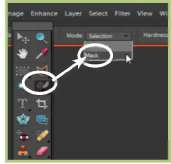
Step 1 >> Choose the Selection Brush (under the Magic Selection Brush) from the tool box and switch the brush to Mask mode.

Step 2 >> Paint on the parts of the picture that you want to shield from the editing process.

Step 3 >> Apply the editing changes to the non-masked areas. Here we applied the Crystallize filter.
6.10 Fill and adjustment layer masks
Suitable for Elements – 7.0, 6.0, 5.0, 4.0, 3.0, 2.0, 1.0 | Difficulty level – Intermediate | Resources – Web image 6.09Related techniques – 6.07, 6.11, 6.12 | Menus used – Layer
Another form of masking is available to Elements users via the Fill and Adjustment Layers features. Each time you add one of these layers to an image, two thumbnails are created in the Layers palette. The one on the left controls the settings for the adjustment layer. Double-clicking this thumbnail brings up the dialog box and the settings used for the fill or adjustment layer. The thumbnail on the right represents the layer’s mask which governs how and where the settings are applied to the image.

Eraser >> Erasing parts of the fill layer reveals the picture beneath.

Black paint >> Painting the mask with black paint has the same effect as erasing.
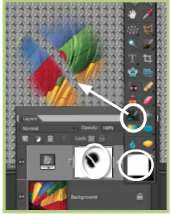
White paint >> Painting with white paint restores the mask and the pattern.
The mask is a grayscale image. In its default state it is colored white, meaning that no part of the layer's effects are being masked or held back from the picture below. Conversely if the thumbnail is totally black then none of the layer’s effects is applied to the picture. In this monochrome world shades of gray equate to various levels of transparency. With this in mind we can control which parts of the picture are altered by the fill or adjustment layer and which parts remain unchanged by painting (in black and white and gray) and erasing directly on the layer mask.
To start editing a layer mask, firstly apply a fill layer such as Pattern to the image. Check to see that the default colors (white and black) are selected for the Elements foreground and background colors. Next select the Eraser tool, and with the fill layer selected in the Layers palette, proceed to remove part of the layer. The pattern is removed and the picture beneath shows through and a black mark now appears in the layer thumbnail corresponding to your erasing actions. Switch to the Paint Brush tool and select black as your foreground color and paint onto the patterned surface. Again this action masks the picture beneath from the effects of the fill layer and adds more black areas to the thumbnail. Painting with white as your foreground color restores the mask and paints back the pattern. You can experiment with transparent effects by painting on the mask with gray. The lighter the gray the more the pattern will dominate, the darker the gray the less the pattern will be seen. A similar semi-transparent effect can be achieved if the opacity of the eraser or brush is reduced.
6.11 Using selections with layer masks
Suitable for Elements – 7.0, 6.0, 5.0, 4.0, 3.0, 2.0, 1.0 | Difficulty level – Intermediate | Resources – Web image 6.08 |Related techniques – 6.09, 6.10, 6.12 | Tools used – Select
In addition to employing painting and erasing tools to work directly on the layer mask you can also use a selection in conjunction with an adjustment or fill layer to restrict the area of your image that is altered. Make a selection in the normal way and then, with the selection still active, create a new adjustment or fill layer. The selection confines the changes made by the new adjustment/fill layer. You will notice the selected area is colored white in the Layer Mask thumbnail. A layer mask made in this way can be edited using the same painting techniques as discussed above.
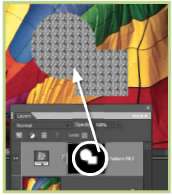
Selection >> By having a selection active when you make a new adjustment or fill layer you immediately restrict the effects of this layer to just the confines of the selection.
6.12 ‘Group with Previous’ masks
Suitable for Elements – 7.0, 6.0, 5.0, 4.0, 3.0, 2.0, 1.0 | Difficulty level – Intermediate | Resources – Web image 609 | Related techniques – 6.09, 6.10, 6.110 | Menus used – Layer
The final masking technique that Photoshop Elements employs uses the special Group with Previous command found in the Layer menu. This command uses the transparency surrounding objects on a layer as a mask for the content of any layers that are above it in the stack. In the example the balloon image was placed above the test text layer. With the balloon layer active the Group with Previous command (Layer > Group with Previous) was selected. The example image now fills the text shape but is masked from showing through the rest of the layer by the transparency surrounding the type. This technique also works with shapes and filled selections drawn on a separate layer surrounded by transparency.
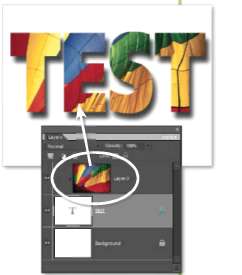

Step 1 >> Create some bold text in a new document with a white background layer.
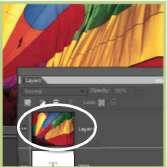
Step 2 >> Copy and paste a color image in a layer above the text.

Step 3 >> Select the color layer and choose the Group with Previous command from the Layers menu.
Step 1 >> Select Image > Mode > Grayscale and then click on the OK button in the Discard Color warning box.
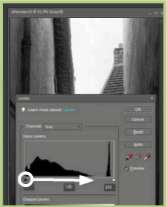
Step 2 >> Using the Levels control, map the dark pixels to black by dragging the black point slider to the right.

Step 3 >> Correct the highlights by dragging the white point slider to the left.

Increase contrast >> By moving the black and white input sliders towards the center of the dialog you can increase the contrast of your picture.
Converting color to black and white
One of the real advantages of shooting digital is the ease with which you can convert color images to black and white. Gone are the days of having to carry two camera bodies, one loaded with color film the other with black and white. Now you simply shoot color all the time and then convert selected images to black and white using a few simple steps.
6.13 Changing the mode to grayscale
Suitable for Elements – 7.0, 6.0, 5.0, 4.0, 3.0, 2.0, 1.0 | Difficulty level – Basic | Resources – Web image 610 | Related techniques – 6.14, 6.15 | Menus used – Image, Enhance
The simplest way to lose the colors in your picture is to convert the image to a grayscale. This process changes the photograph from having three color channels (red, green and blue) to being constructed of a s i ngle channel that contai ns the pict u re’s det ai l on ly . O ften this conversion produces a flat and lacklustre photograph and so a little manipulation of the tones is in order. My first point of call to help solve this problem would always be the Levels dialog (Enhance > Adjust Lighting > Levels). Using this control you can make sure that your image tones are spread across the grayscale spectrum.
Most grayscale conversion pictures need a general contrast increase. You can achieve this by moving the black and white input sliders towards the center of the dialog. Holding the Alt key down whilst you are moving the slider will enable you to preview the pixels that are being converted to pure black or pure white. Your aim is to map the darkest pixels in the picture to black and the lightest ones to white. Work carefully here as a heavy handed approach will produce pictures where delicate shadow and highlight details are lost forever.
Grayscale >> You can convert your color digital photographs to grayscale using two different methods in Adobe Photoshop Elements. The simplest is to change color modes from RGB to Grayscale. The alternative is to desaturate the photograph. This process has the added advantage of leaving the black and white picture in RGB mode so that color can be added to the monochrome later. Images created with either process do benefit from some adjustment of tones after conversion.
6.14 Desaturate the color file
Suitable for Elements – 7.0, 6.0, 5.0, 4.0, 3.0, 2.0, 1.0 | Difficulty level – Basic | Resources – Web image 611 Related techniques – 6.13, 6.15, 6.16 | Tools used – Dodge and Burn-in | Menus used – Image
Photoshop Elements uses the term ‘saturation’ to refer to the strength of the colors in a picture. Increasing saturation makes the colors in a picture more vivid, decreasing saturation makes the hues weaker. The program employs the Hue/Saturation (Enhance > Adjust Color > Hue Saturation) control to adjust the color’s strength. If the Saturation slider is moved all the way to the left of the dialog (to a setting of -100) then all color is removed from the picture. You are effectively left with a grayscale or black and white photograph that is very similar to the ‘convert to grayscale’ version above but with one important difference – the picture is still an RGB file. This means that even though the photograph no longer contains any color, the color mode it is stored in is capable of supporting

Step 1 >> Select the Hue/Saturation control from the Adjust Color heading in the Enhance menu.

Step 2 >> Move the Saturation slide completely to the left, removing all color from the picture.

Step 3 >> Use the Dodging and Burning-in tools to lighten and darken selected areas of the picture.
color. So if you are wanting to try a little digital hand coloring, or experiment with pictures that contain monochrome as well as color components, then this is the technique for you. More details on these techniques can be found later in this book. Be warned though, once your picture is desaturated the color is lost for ever and so it is always a good idea to save a copy of the color version of the image before proceeding.
![]() You can shortcut the desaturation process by selecting Enhance > Adjust Color > Remove Color, which provides the same results as using the Hue/Saturation control but in a single step.
You can shortcut the desaturation process by selecting Enhance > Adjust Color > Remove Color, which provides the same results as using the Hue/Saturation control but in a single step.
Once the picture has been desaturated you may need to tweak the shadow, highlight and midtones using the Levels feature. Finally, add some drama to the picture by selectively lightening and darkening parts of the image using the Dodging and Burning-in tools. Used judiciously these devices can change the whole atmosphere of a photograph. In the example, I darkened the walls closest to the viewer and lightened those parts of the French alley way that were in the background. These changes increased the sense of distance in the picture as well as helping to draw the viewer’s eyes into the picture.

Desaturation shortcut >> The Enhance > Adjust Color > Remove Color option is a shortcut that produces the same results as moving the Saturation slider to -100 in the Hue/ Saturation feature.

Saturation control >> By decreasing the saturation of the colors in a picture completely you convert the image to just black and white.
6.15 A more sophisticated approach
Suitable for Elements – 7.0, 6.0, 5.0, 4.0, 3.0, 2.0, 1.0 | Difficulty level – Basic | Resources – Web image 612 Related techniques – 6.13, 6.14, 6.16 | Menus used – Layer
Despite the straightforward nature of the two conversion approaches detailed above, transforming a color photo to grayscale is not as simple as it first seems. Many converted images seem a little flat and lack the separation of tones that existed in the original photo. The trick with good conversions from color to grayscale is ensuring that the hues in the original picture are translated into distinct and different tones. For this reason no one conversion process will be suitable for all pictures.
Take for instance the example of a red flower photographed against the background of rich green foliage. When converted to grayscale by switching modes or desaturating there is a tendency for both the red of the flower and the green of the leaves to be converted to the same gray tone, making the monochrome picture much less vibrant and dynamic than the original. In order to restore some visual separation between flower and background it is necessary to convert these hues to different grays.
Just such a technique was developed by the Adobe evangelist, Russell Brown (www. russellbrown.com). The original method was designed for Photoshop but works just as well with Elements. It uses the Adjustment Layers technology in Photoshop Elements as a way to both convert the color image to black and white and also to control how the colors are represented in the grayscale. Like a lot of Russell’s techniques it leaves the original image unchanged in the background. Hence this style of image enhancing is called non-destructive editing.

Step 1 >> Make a new Hue/Saturation layer above your background. Don’t make any changes to the default settings for this layer. Set the mode of the adjustment layer to Color. Label this layer ‘Filter’.

Step 2 >> Make a second Hue/Saturation adjustment layer above the Filter layer and alter the settings so Saturation is -100. Call this layer Black and White Film. The monochrome image now on screen is the standard result we would expect if we just desaturated the colored original.

Step 3 >> Next double-click on the layer thumbnail in the Filter layer and move the Hue slider. This changes the way that the color values are translated to black and white. Similarly, if you move the Saturation slider you can emphasize particular parts of the image.
Gray conversion options >> Photoshop Elements provides a variety of options when you are wanting to convert color pictures to a grayscale or black and white photo. (a) Original color photo. (b) Change to grayscale mode. (c) Desaturate the photo. (d) The Russell Brown technique.

More control >> For more precise control of the separation of tones you can restrict your changes to a single color group (red, blue, green, cyan, magenta) by selecting it from the drop-down menu before manipulating the Hue and Saturation controls.
6.16 The Convert to Black and White feature
Suitable for Elements – 7.0, 6.0, 5.0 | Difficulty level – Basic
Resources – Web image 613 | Related techniques – 6.13, 6.14, 6. 15 | Menus used – Enhance
Taking this idea further in Elements 5 Adobe introduced a new Convert to Black and White feature (Editor: Enhance > Convert to Black and White). It provides the ability to customize the way that color areas are mapped to gray during the conversion process. The dialog consists of large before and after previews, a series of six conversion styles that are based on popular subject types or conversions and four slider control buttons for fine-tuning the results.
This feature provides the options for more sophisticated conversions by allowing the user to adjust which colors (red, green or blue) feature more prominently in the final result.
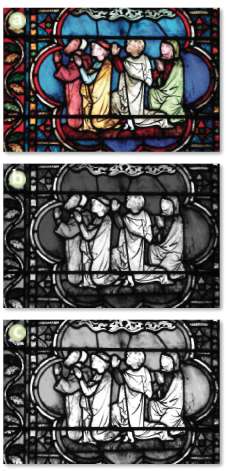
Convert to Black and White >> From version 5.0 Photoshop Elements has contained a custom control for transforming color photos to grayscale. The Convert to Black and White feature allows you to control how the colors are mapped to gray. (a) Original color photo. (b) Desaturate or Remove Color conversion. (c) Convert to Black and White conversion emphasizing the blue areas in the original color photo.
Convert to Black and White >> The Convert to Black and White dialog contains a before and after preview, six different conversion styles or flavor presets as well as a set of adjustment buttons that can be used for customizing the way that particular colors are mapped to gray.
This feature is great for situations where the color contrast of a scene isn’t reflected in the monochrome conversion. Imagine the color contrast of a red rose against green foliage. Using a simple conversion feature such as Remove Color would result in both the rose and foliage being the same tone of gray. With Convert to Black and White the contrast of the original can be retained in the result by boosting or reducing the prominence of green or red parts of the picture.

Step 1 >> With a suitable color image open in the Full Edit workspace select the Convert to Black and White feature from the Enhance menu. Click through the different conversion styles menu checking the After preview for a suitable result. Click OK to apply the conversion, Reset to remove current settings or Cancel to quit the feature.
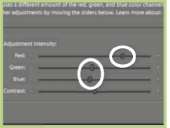
Step 2 >> For a more customized conversion start by selecting a conversion style that is closest to your desired result and then fine-tune the results with one of the Adjustment Intensity sliders. The effects can be more dramatic by also applying the opposite adjustment in the other two color channels.

Step 3 >> In situations where the changes you make produce results that are undesirable you can return the after image back to its default state by clicking the Reset button in the top right of the dialog.
Custom Black and White >> You can create your own custom black and white style presets by editing the bwconvert.txt file (f) located in the Program FilesAdobePhotoshop Elements 7.0Required folder (e). Alternatively, you can download and copy my own version of this file to the directory. It contains four custom conversion options Dark Skies (a), Moody (b), Separate Red Green (c) and White Skin (d). After restarting Elements the new options will appear in the Styles menu of the feature (g).
6.17 Custom entries in Convert to Black and White
Suitable for Elements – 7.0, 6.0, 5.0 | Difficulty level – Basic | Resources – Web image 614 | Related techniques – 6.14, 6.15, 6.16 | Menus used – Enhance
The preset style entries in the Convert to Black and White feature are controlled by a simple text file located in the settings folders of the program. The features settings file is called ‘bwconvert.txt’ and is located in the C:Progmm FiksAdobePhotoshop Elements 7.0Required folder. The file sets the values for the styles and can be easily edited if a user wants to have their own conversion preset values. Just make sure that you create a new line for each entry and follow the style of the other settings. You will also need to restart Elements for the new entries to take effect. Of course, I highly recommend backing up the installed version of the file so that you can easily restore the settings back to the default values.
If all this sounds too difficult then just download my customized version of the ‘bwconvert.txt’ file and copy it to the C:Progmm FiIesAdobePhotoshop Elements 7.0Required folder. My version contains four extra presets (Dark Skies, Moody, Separate Red Green and White Skin) designed to extend the styles in the feature further and provide some example conversions that you might find useful. As with all styles, to fully suit your images, apply the style first and then tweak the results with the sliders.
6.18 The Gradient Map conversions3
Suitable for Elements – 7.0, 6.0, 5.0 | Difficulty level – Basic | Resources – Web image 615 Related techniques – 6.13, 6.14, 6.15 | Menus used – Enhance
Yet another way to convert a color image to grayscale is to employ the abilities of a Gradient Map Adjustment Layer. When set to a black to white gradient, this feature maps the tones and colors in an image so that they are evenly distributed along the gradient’s tonal range. This creates a conversion with good overall contrast, as the darkest point of the photo is mapped to black and the lightest to white, but by playing with the gradient itself, you can also tweak the brightness of other tonal areas in the image as well. So with this technique you get to make the conversion, and adjust how shadows, midtones and highlights are mapped to gray. Cool!
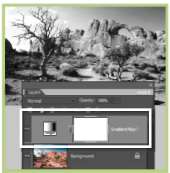
Step 1 >> To start let's make a simple Gradient Map grayscale conversion. Do this by adding a Gradient Map adjustment layer to the layers stack (Layer > New Adjustment Layer > Gradient Map). Next select a Black to White gradient from the drop-down menu. Click OK and the conversion is complete.

Step 2 >> To start to control how shadows midtones and highlights are mapped to gray we need to create a custom gradient In the Gradient Editor. Double-click on the Gradient Map thumbnail to open the feature’s dialog. Next click onto the displayed gradient to open the Gradient Editor.

Step 3 >> At the moment the gradient has a color control (called Stops) at either end of the gradient – black and white. We want to add extra Stops for 25%, 50% and 75% brightness values. Do this by clicking just below the gradient. This adds a new Stop. Doubleclick the stop to open the Select Stop Color dialog. Type the gray value in the ‘B’ section for the HSB values. Click OK.
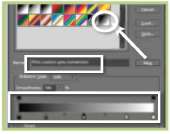
Step 4 >> Repeat the process adding in the other gray stops. Don’t worry too much about their position along the gradient as we can alter this, just try to ensure that the 25% brightness value is left of center, 50% about center and 75% brightness is right of center. Once all the stops have been created add a name for the gradient in the Name area and click the New button to add the gradient to those listed in the palette. Don’t click OK.
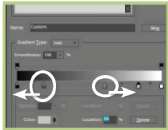
Step 5 >> To manipulate how the tones are mapped to gray click on a stop and drag it along the gradient in the Gradient Editor. In this example the shadows were lightened by dragging the 25% brightness stop to the left and midtones were darkened by dragging the 50% darkness to the right. The changes will be previewed in your image as long as the Preview option is ticked in the Gradient Map dialog.

Step 6 >> Finally to apply the conversion click the OK buttons in the Gradient Editor and the Gradient Map dialogs. The tones can be adjusted at a later date by double-clicking on the adjustment layer thumbnail and then clicking the gradient. This will display the Gradient Editor complete with your custom gradient containing the three additional brightness stops.
6.19 Borrowing Photoshop’s Black and White
Suitable for Elements – 7.0, 6.0, 5.0 | Difficulty level – Basic | Resources – Web image 6.16 | Related techniques -6.13, 6.14, 6.15 | Menus used – Enhance
At the same time that Elements users were enjoying the monochrome mapping power of the Convert to Black and White feature, Photoshop CS3 users were also given a specialized conversion feature called, Black and White. The new feature is available for use directly on an image or via an Adjustment Layer. It contains six slider controls that adjust how specific color ranges are mapped to gray. In addition, there is a toning option at the bottom of the dialog which provides the ability to tint the converted monochrome.
Even though this is a Photoshop-only feature, we can make use of its color to gray mapping abilities. Just drag an existing Black and White adjustment layer from a document created in Photoshop, but opened into Elements, onto an Elements file. Just like magic the layer is added to the Elements document and the conversion applied. Just in case you don’t have Photoshop handy I have created a special donor document called, Photoshop-Convert-to-Gmy.psd, which contains ten different conversion layers. For you to have the Photoshop feature working on your documents just download the file from the book’s website, open it into the edit workspace and drag one of the layers to your Elements document.

Step 1 >> Start by opening both the Photoshop donor document (Photoshop-Convert-to-graypsd) and the Elements file that you want to enhance. Click onto the Photoshop document and scroll through the list of adjustment layers available in the document. Select a layer and click-drag it onto the Elements document. The enhancement change will be immediately previewed in the workspace.

Step 2 >> Multiple Photoshop layers can be dragged onto the Elements document and their effects hidden or applied by clicking the ‘eye’ icon on the left of the layer entry.
Advanced dodging and burning-in
After years of my ‘hit and miss’ approach to dodging and burning in the darkroom I can still remember my reaction to seeing Photoshop Elements performing real-time lightening and darkening – ‘You are kidding!’. Not only could I paint in light and dark areas on my picture using a soft-edged brush, I could also vary the strength of the effect and the size of the brush used for application. In addition, I could choose to alter shadow, midtones or highlights separately and ‘undo’ my actions with a single keystroke. All this flexibility and with the lights on as well!
I would think that most new users to Photoshop Elements would experience much of the same excitement as I did when they first discover the Dodge and Burn-in tools. For the majority of simple enhancement tasks a few quick strokes of these tools will provide plenty of control over your picture’s tones, but there are occasions when you need a little more flexibility. I use the following techniques to provide a little more customization to my dodging and burning-in in my work.
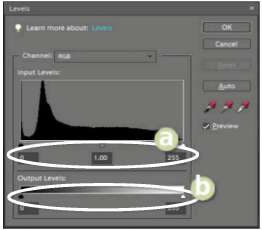
Input and output sliders >> (a) Black, midtone and white Input sliders. (b) Black and white Output sliders.
6.20 Using selections to change tone
Suitable for Elements – 7.0, 6.0, 5.0, 4.0, 3.0, 2.0, 1.0 | Difficulty level – Intermediate | Resources – Web Image 617 Related Techniques – 6.18 | Tools used – Selection tools| Menus used – Select
You can evenly alter the tone of a large area of your picture quickly by making a feathered selection of the area first and then using the Levels control to darken or lighten the pixels. The amount you feather the selection will determine how soft the transition will be between dodged or burnt areas and the original picture. Using the Levels feature gives you great control over the brightness of shadow, mid- tone and highlight areas.
By manipulating the Input and Output sliders you can selectively alter specific tones in your image. You can also decrease or increase the contrast of the selection as well.
Use this table to help get you started.
| Required image change | Action to take |
| To lighten the midtones of a selected area | Move the midpoint input triangle to the left |
| To darken the midtones of a selected area | Move the midpoint input triangle to the right |
| To lighten the midtones and highlights | Move the white point input triangle to the left |
| To darken the midtones and shadows | Move the black point input triangle to the right |
| To lighten the shadow tones | Move the black point output triangle to the right |
| To darken the highlight tones | Move the white point output triangle to the left |
| To decrease contrast | Move the white and black point Output sliders closer together |
| To increase contrast | Move the white and black point Input sliders closer together |
Step 1 >> Using one of the selection tools draw a rough selection around the area to dodge or burn-in.

Step 2 >> Feather and then inverse the selection. Use a large pixel amount for high-resolution pictures

Step 3 >> With the selection still active manipulate the Levels Input and Output sliders to darken/lighten tones.
Pro’s Tip: Non-destructive dodging and burning-in
If you want to dodge and burn but not make any permanent changes to the picture you can use the same feathered selection technique, but apply the changes through an adjustment layer. Make the selection as before, feathering (Select > Feather or Refine Edge) the edge and inversing (Select > Inverse) the selection. With the selection still active, click onto the Create New Adjustment Layer button on the top of the Layers palette and choose Levels. If the Layers palette is not visible then you can perform the same action via the Layer menu (Layer > New Adjustment Layer). The Levels dialog appears and any changes made with the sliders alter the tones in the selected area of the picture just as before. The difference with this approach is that the dodging and burning-in takes place via an adjustment layer, leaving the original picture unchanged in the layer beneath. The selection is used as a basis to form a mask in the adjustment layer. We view the levels changes through the clear areas of this mask only. A second advantage to this approach is that the levels settings can be changed at a later date. Simply double-click the thumbnail on the left-hand side of the layer and alter the Levels settings.

Step 1 >> With your feathered selection active click the New Adjustment Layer button.
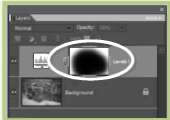
Step 2 >> Select the Levels adjustment layer and adjust the dialog’s settings to Dodge and Burn-in.
A second non-destructive approach that was pioneered by Julianne Kost starts with you creating two empty layers above the background or image layer. Name them Dodge and Burn and set the blending mode for both of them to Soft Light. Using a Black brush at a low opacity (10-15%) paint on the burn layer to darken areas. Use a White brush at the same opacity on the dodge layer to lighten. This provides a nondestructive, subtle and artistic method for dodging and burning-in.
Dodging and burning-in >> Dodging and burning-in has always been used to add a little visual drama into photographs. The careful lightening and darkening of areas of the print can create a sense of depth and also help to direct the viewer’s eye to specific focal points in the image. Image courtesy of www.ablestock.com Copyright 2005.
6.21 Erase back through tonal layers
Suitable for Elements – 7.0, 6.0, 5.0, 4.0, 3.0, 2.0, 1.0 | Difficulty level – Intermediate | Resources – Web image 617 | Related Techniques – 6.16 | Tools used – Eraser Menus used – Enhance, Layer
A more artistic approach to dodging and burning-in can be found in a technique that involves making several different copies of the base picture. The background layer can be copied by either choosing Layer > Duplicate Layer or by dragging the layer to the Create New Layer button at the bottom of the Layers palette.
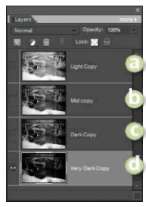
Dodge and burn via erase >> Make creative tonal changes using the Eraser tool and several adjusted layer copies. (a) Light copy. (b) Midtone/normal copy. (c) Dark copy. (d) Very dark copy.
Each copy is stored on a separate layer and the overall tone of the duplicate image is changed using the Layers control. In the example I have created four layers, labelled them light, midtone, dark and very dark, and changed their tones accordingly. Next I selected the Eraser tool, set the mode to brush, the edge option to soft and the opacity to 20%. I then clicked on the Eye icon in both the light and midtone layers and selected the dark layer. Using the Eraser in overlapping strokes, I gradually removed sections of the dark layer to reveal the very dark layer beneath. I then selected the midtone layer and performed the same action and finally I selected the light layer and erased sections to reveal the darker layers below. If this all sounds a little confusing, try thinking of the erasing action as actually painting the image darker, or burning the picture area in, and take my advice – make sure that you name your layers as you create them. This technique works particularly well if used with a graphics tablet as the opacity of the erasing stroke can be linked to the pressure on the stylus. Pressing harder with the stylus erases more of the layer and creates a greater change. Lighter strokes can be used to produce more subtle adjustments.

Step 1 >> Make several copies of the basic image layer by dragging the layer to the Create New Layer

Step 2 >> Select each layer in turn and alter the overall brightness using the Levels dialog.

Step 3 >> Rename the layers by double-clicking the names in the Layers palette.

Step 4 >> Turn off the Eye icon for the light and midtone layers and select the dark layer.

Step 5 >> Using the Eraser tool remove parts of the dark layer to reveal the very dark picture below.

Step 6 >> Work your way through the other layers gradually removing unwanted areas to build up the picture.
Masked based layers
To ensure the maximum ability to customize how the layers are applied you can make use of the mask in a No Settings adjustment layer to hide or reveal the detail for any particular layer. To work this way add No Settings adjustment layers below each of the top three image layers. Then use the Group with Previous command to link the image and adjustment layers.

Step 1 >> Start by adding a No Settings adjustment layer below each of the image layers. Next Select the image layer and then Choose Layer > Group With Previous to view the layer detail through the adjustment layer mask.

Step 2 >> After selecting the Adjustment Layer Mask use a black Brush to paint in the areas of the layer that will be hidden from view (that will allow the detail from beneath to show through).
6.22 Paint on dodging and burning-in
Suitable for Elements – 7.0, 6.0, 5.0, 4.0, 3.0, 2.0, 1.0
Difficulty level – Intermediate | Resources – Web image 618
Related Techniques – 6.20, 6.21 | Tools used – Brush Menus used – Layer
What if you want the flexibility of painting in your density changes (dodging and burning) but wanted to apply these changes non- destructively to your photo? Well, a solution can be found by combining aspects of the last technique with our understanding of adjustment layers and their associated layer masks.
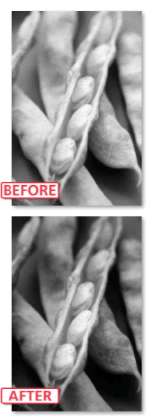
‘Paint on’ image changes >> Use the mask of the Levels adjustment layer to paint burn and dodge effects non-destructively onto your photos.
Start by adding a Levels adjustment layer (Editor: Layer > New Adjustment Layer > Levels) to your photo. In the Levels dialog drag the Input midpoint slider to the right and the Output white point slider to the left. This will create an adjustment layer effect that darkens the whole image. Think of this change as how the image would look if you applied the Burn tool to the whole picture. Click OK to apply the change. Nothing new here you say. True, but what if we could selectively paint in this effect rather than apply it to the whole image? Well here is the trick. Click on the mask of the adjustment layer and fill it with black (Editor: Edit > Fill Layer). Remember black hides the adjustment layer effect so you should see the original tones of your photo restored in the preview window. With the mask still selected choose a soft-edged brush, lower the opacity slightly and make sure the paint colour is white.
Now paint onto the surface of the photo. The painted areas will darken. In reality you are not painting the photo but rather painting the mask and in so doing adding the adjustment layer effect in these areas.
Step 1 >> Create a new Levels adjustment layer that darkens the photo.

Step 2 >> Select the layer mask of the adjustment layer in the Layers palette and fill with black.

Step 3 >> To burn non-destructively brush onto the photo with white whilst the layer mask is still selected.
6.23 Blend mode Dodge and Burn
Suitable for Elements – 7.0, 6.0, 5.0, 4.0, 3.0, 2.0, 1.0 | Difficulty level – Intermediate | Resources – Web image 619 | Related Techniques – 6.20, 6.21 | Tools used – Brush | Menus used – Layer
One final technique for dodging and burning makes use of the Soft Light Blend Mode to change the brightness of different picture parts non-destructively. Start by adding a new layer above the background or main image layer. Next change the layer’s Blend Mode setting to Soft Light. Now target the new layer and with a black soft-edged brush paint over the picture areas to be darkened. To lighten a portion of the image, switch to a white foreground color (click ‘x’ for a quick change between foreground and background colors) and paint over these areas. The Blending Mode applies the changes in brightness and the fact that the painting is stored in a separate layer makes the technique non-destructive.

Step 1 >> Create a new layer and then change the Layer Blend Mode to Soft Light.

Step 2 >> Target the new layer and paint over the areas to be burned in with a black soft-edged brush.

Step 3 >> To lighten a picture part, switch the foreground color to white and paint again. Adjust the brushes opacity to fine tune the changes.
Enhance your poorly exposed pictures
Good exposure is the cornerstone of great images. No matter how good your subject is, how well you have composed the image or how brilliantly you captured the scene, if your exposure is a little astray then you will be left with a less than perfect result. This is just as true for digital images as it was for traditional photographs. Overexposure leads to delicate highlight detail being recorded as pure white; underexposure on the other hand produces a picture with little detail in the shadow areas.
The best way to solve these problems is to re-shoot your picture using an aperture and shutter combination that will produce a well-exposed image but, as we all know, sometimes a ‘re-shoot’ is just not possible. So how can Photoshop Elements help us enhance our poorly exposed pictures? I have found the following techniques particularly helpful when trying to enhance, or should that be disguise, images that are suffering from bad exposure.
6.24 Screening image layers to enhance tones
Suitable for Elements – 7.0, 6.0, 5.0, 5.0, 4.0, 3.0, 2.0, 1.0 | Difficulty level – Intermediate Resources – Web image 620 | Related Techniques – 6.20 | Menus used – Layer, Enhance
The shadow and midtones of a picture are areas that suffer greatly when a photograph is underexposed. Valuable details are lost, the individual tones are too dark and the whole area is lacking in contrast. One way to help rectify this problem is to make an exact copy of the pictures and then combine the two images together in order to multiply the apparent detail and tone in the shadow areas. Photoshop Elements, via layers and blending modes, provides us with the tools necessary to perform these actions.
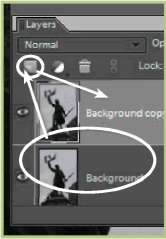
Step 1 >> Copy the background layer by dragging it to the New Layer button in the Layers dialog.

Step 2 >> Select the copied layer and then change the blending mode to Screen.

Step 3 >> As a final touch insert a Levels Adjustment layer between the two layers. Peg the black and white points and lighten the midtones by dragging the midpoint to the left.
Firstly, duplicate the background (image layer) by dragging it to the New Layer button at the bottom of the Layers dialog. Now, with the copy layer selected, change the layer blending mode to Screen. You should see an immediate brightening of the picture and the appearance of more detail in the shadow areas.
As a final tweaking of the image insert a Levels adjustment layer between the two layers. Do this by clicking on the bottom layer first and then selecting Levels from the drop-down list found when clicking the Create New Adjustment Layer button at the bottom of the Layers palette. Peg the highlights and shadows of the picture by moving the black and white points towards the center until they meet the first pixels in the histogram. Next, move the midtone to the left to increase the overall brightness of the image.

Correcting underexposure >> The best way to guarantee a great looking image where the tones are well distributed is to ensure that your exposure settings are correct before pushing the button. If, as is the case in this example, your camera meter is fooled by the scene then you can rescue an underexposed picture using a technique that involves duplicating the base image and then selecting the Screen option as the blending mode.
Those of you who are intimate with Elements will no doubt be asking ‘Why not just use the Fill Flash or Shadows/Highlights feature to fix this underexposure problem?’ and you are right to ask that question. The Fill Flash option is a great tool for lightening mid to dark tones that have plenty of details, but I have found that this ‘duplication layers’ technique provides a more pleasing result for underexposed images with little shadow information.
Solving exposure problems when shooting
The statue picture not only provides a great example for this technique but also demonstrates how such underexposure can occur. Set against a white overcast sky this dark statue was underexposed because the camera’s meter was fooled by the bright sky behind the subject and therefore provided a shutter/aperture combination which was too dark. The thinking photographer would have predicted this problem and used the Exposure Compensation system on the camera to increase exposure by one to one-and-one-half stops to adjust for the back lighting. Most mid range digital cameras and above incorporate an Exposure Override system like this.

Exposure compensation >> Use the camera’s Exposure Compensation system to override your camera’s settings.
To try this for yourself, the next time you encounter a back lit scene shoot two pictures – one with the camera set to auto and the other where you have added to the exposure. Compare the results later on the desktop, or better still, check your exposure in the field by examining the histogram graph of your image on you camera’s monitor. This graph works exactly the same way as the graph in the Levels feature in Photoshop Elements. It displays the spread of tones of your image across a grayscale from black to white. Underexposure will result in a graph that bunches towards the black end of the spectrum whereas overexposure moves the pixels towards the white point. A simple check of this graph when shooting can indicate whether you need to adjust your camera and re-shoot to compensate for an exposure problem.

Step 1 >> With the image at 100% magnification apply the Add Noise filter with Uniform/Monochrome settings.

Step 2 >> Select Burn-in tool, reduce exposure to 10% and choose mid-tone range. Set brush size and edge softness.

Step 3 >> Burn-in the white area using several overlapping strokes to build up the effect. Change to Shadow range and repeat if necessary.
Texture burn-in >> (a) Original image with blown highlights. (b) Highlights burnt in using Burn-in tool. (c) Highlights burnt in after adding a little texture.
6.25 Adding detail to highlights and shadows
Suitable for Elements – 7.0, 6.0, 5.0, 4.0, 3.0, 2.0, 1.0 | Difficulty level – Intermediate | Tools used – Dodging and Burning-in | Menus used – Filter
Sometimes, despite the utmost care on behalf of the photographer, digital images are captured with little or no shadow or highlight details. This scenario should ring true for any reader who has had the pleasure of photographing in very sunny countries. Along with the warmth, strong sun can provide a problem with contrast for the photographer. The deepest shadows and the brightest highlights are so far apart that even the best digital cameras have difficulty in recording all the tones. The result is a picture where either shadow or highlight detail (or in some extreme cases both) is not recorded. These parts of the picture are converted to pure black and white pixels in a process referred to as ‘clipping’.
The same scenario can occur when using a scanner to convert slide or film originals into digital files. Incorrect scanner settings coupled with slides that are very dark or negatives that have been overdeveloped are the circumstances that most often produce ‘clipped’ files.
When presented with such pictures the experienced Elements user will attempt to restore detail in the highlight and shadow areas using the program’s Dodging and Burning-in tools. But often such action only results in murky gray highlights and washed out shadow areas. The problem is that the program has no detail in these parts to actually lighten or darken. A solution to this scenario is to add a little (very little) texture to the image and then dodge and burn-in. The texture breaks up the pure white and pure black areas by filling these picture parts with random multi-tone (black, gray and white) pixels. This gives the tools some detail, albeit artificially created, to work on.
I use the Add Noise filter (Filter > Noise > Add Noise) to provide the texture and then select the Dodging tool set to midtones to work on the dark tones, or you could use the Burning-in tool also set to midtones to work on the highlights. A low exposure value of around 10% is coupled with repeated strokes over the offending area. To restrict the noise to just the highlight areas you could select these first using the Magic Wand and then apply the Noise filter.
This technique does have its down side. It doesn’t recreate lost details and you will need to degrade your image by making it more noisy before you can dodge and burn. So it can’t be considered a magic ‘cure all’ for problem pictures but it can help you get a little detail into that annoyingly white highlight or that equally frustrating blocked shadow area.
Tinted monochromes
One of the most enduring techniques utilized by photographers the world over is the practice of toning or changing the color of their black and white prints. The Sepia tone (brown) look has come to be linked with quality image production partly because it was a process that increased the longevity of black and white pictures and partly because only committed photographers would take their work through this extra processing step. Digital photographers have the tools at hand to not only ‘tone’ their black and white images but also to apply this same technique to their color ones.

Toning >> Use the Hue/Saturation control (Enhance > Adjust Color > Hue/ Saturation) to quickly and effectively add a tint to your color images.
6.26 Using Hue and Saturation to tone your pictures
Suitable for Elements – 6, 5.0, 4.0, 3.0, 2.0, 1.0 | Difficulty level – Intermediate | Resources – Web image 621 Related techniques – 6.27 | Menus used – Enhance
The simplest and fastest way to add color is to use the Hue/Saturation control (Enhance > Adjust > Color > Hue/Saturation). This can be applied directly to the whole image or as an adjustment layer (Layer > New Adjustment Layer > Hue Saturation). To change the feature into a toning tool click the Colorize option in the bottom right of the box. The picture will switch to a single color monochrome (one color plus white and black). The Hue slider now controls the color of your tone.
The sepia look in the example is a value of 30 on the Hue slider. The Saturation slider varies the strength of the color. The Saturation value used in the example was 25. The Lightness slider adjusts the brightness of the image but changes of this nature should be left for the Levels feature.

Hue/Saturation toning >> Check the Colorize option to convert the dialog to Toning mode.
The predictability of this digital toning system means that you can achieve the same tint in each image for a whole series of pictures. The recipes for regularly used tones, or favorite colors, can easily be noted down for later use or if toning using an adjustment layer then the layer can be dragged from one image to another. You can even create a Toning palette like the example on the next page, which provides a range of tint options as well as hue strengths.
Toner recipes >> Use the recipes for the tints belo to help guide you when toning using the Hue/ Saturation control. Simply plug in the following numbers for the Hue, Saturation and Lightness sliders. (a) 0, 75, 0 (b) 0, 50, 0 (c) 0, 25, 0 (d) 30, 75, 0 (e) 30, 50, 0 (f) 30, 25, 0 (g) 80, 75, 0 (h) 80, 50, 0 (i) 80, 25, 0 (j) 190, 75, 0 (k) 190, 50, 0 (l) 190, 25, 0 (m) 250, 75, 0 (n) 250, 50, 0 (o) 250, 25, 0
6.27 Tinting borrowed from Photoshop
Suitable for Elements – 7.0, 6.0, 5.0, 4.0, 3.0, 2.0, 1.0 Difficulty level – Intermediate | Resources – Web image 621 | Related Techniques – 6.26, 6.28
Tools used – Brush | Menus used – Layer
We have already seen how we can borrow adjustment layers from Photoshop documents to handle our conversions to grayscale, but there is also the opportunity to tint your photos with the same Black and White feature. Nestled at the bottom of the dialog is a tint control that contains the same Hue and Saturation sliders that feature in the Hue Saturation adjustment layer.
After setting the conversion sliders, ticking the Tint options changes the image from a grayscale to a toned monochrome. The Hue slider determines the color of the tint and the Saturation slider the strength of the tint color.

Photoshop’s Black and White feature >> After borrowing the Black and White adjustment layer, Elements users can open the feature’s dialog by double-clicking the layer’s thumbnail. At the base of the dialog is a Tint option that provides the opportunity for you to tone the images you convert to grayscale with the feature.
To gain access to this Photoshop feature simply drag a Black and White adjustment layer from the donor document ('Photoshop-Convert-to-gray-tinting.psd’) which is available from the book’s website, to an open Elements file. There are several different tinting adjustment layers to choose from.
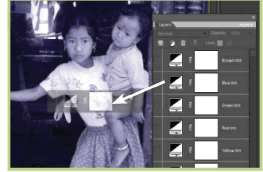
Step 1 >> Start by opening both the Photoshop donor document (Photoshop-Convert-to-gray-tinting.psd) and the Elements file that you want to enhance. Click onto the Photoshop document and scroll through the list of adjustment layers available in the document. Select a layer and click-drag it onto the Elements document. The enhancement change will be immediately previewed in the workspace.
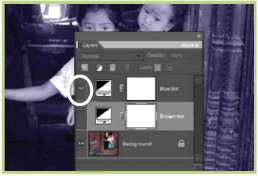
Step 2 >> Multiple Photoshop layers can be dragged onto the Elements document and their effects hidden or applied by clicking the ‘eye’ icon on the left of the layer entry.
Split toning
Once you have mastered the art of toning your pictures it is time to spread your ‘tinting’ wings a little. One of my favorite after-printing effects back in my darkroom days was split toning. This process involved passing a completed black and white print through two differently colored and separate toning baths. This resulted in the print containing a mixture of two different tints.
For example, when an image is split toned with sepia first and then blue toner the resultant picture has warm (brown) highlights and midtones, and cool (blue) shadows. Getting the right toning balance between the two solutions was difficult and then trying to repeat the process uniformly over a series of images was even harder. Thankfully I can replicate the results of split toning in my digital picture with a lot less trouble and a lot more predictability.

Split tone >> With the aid of some tricky selection techniques it is possible to tint different tonal ranges of an image with alternative colors. This style of tinting is called split toning and traditionally is created by passing a photographic print through multiple toning baths.
6.28 Select and tone
Suitable for Elements – 7.0, 6.0, 5.0, 4.0, 3.0, 2.0, 1.0 | Difficulty level – Intermediate| Resources – Web image 622 | Related techniques – 6.26 | Tools used – Magic Wand | Menus used – Select, Enhance
In order to tint a select range of tones such as midtones and shadows I must first select these areas of the image. The Magic Wand tool makes selections based on color and tone and so is perfectly suited for this type of selection. Normally we would use this tool with the Contiguous option turned on so that the selection comprises pixels that sit next to each other, but for this
Magic Wand settings >> When using the Magic Wand to select a range of tones in an image be sure to turn off the Contiguous setting, increase the Tolerance value and then select your reference pixel.
task turn this option off. The Tolerance value for the tool can range from 0 to 255. This setting determines how close to the selected pixel’s t o n e the other pixels need to be before they too are included in the selection. The 0 setting is used to select other pixels in the image with exactly the same color and tone, whereas a setting of 20 will select other pixels that vary by as much as 20 tonal/color steps from the original.
With this in mind we can easily employ this tool to select just the shadow and midtones of an image by setting the tolerance to a value of about 120 and then selecting the darkest part of the image (which we will assume has a value of 0 and therefore is black). The Magic Wand will then search the picture for pixels with a tonal value between 0 and 120. The resultant selection will include both shadows and midtones. It is then a simple matter of using the Hue/Saturation control to colorize these tones. To tint the rest of the pixels in the picture in an alternative color you must first invert the selection (Select>Inverse) and then repeat the Hue/ Saturation toning procedure.
To soften the transition at the split of the two colors apply a feather of 1 or 2 pixels (Select > Feather) after your initial selection.
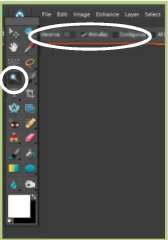
Step 1 >> Select the Magic Wand tool, adjust the Tolerance value and deselect the Contiguous option.

Step 2 >> Feather the selection by a value of 1 or 2 pixels to soften the split between toning colors.

Step 3 >> Tone the selected areas using the Hue/Saturation control.
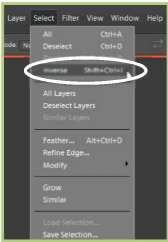
Step 4 >> Inverse the selection and tone the remaining pixels using an alternative color.
6.29 Two -layer erase
Suitable for Elements – 7.0, 6.0, 5.0, 4.0, 3.0, 2.0, 1.0 | Difficulty level – Intermediate | Resources – Web image 623 Related Techniques – 6.28 | Tools used – Eraser | Menus used – Layer, Enhance
You can extend the split toning idea beyond its darkroom origins by using this technique to create an image where one part of the picture is toned one color whilst the rest is colored in an alternative hue. To achieve this effect duplicate the image layer and then select and tone each layer in turn. Then use the mask from a No Settings adjustment layer to remove parts of the upper layer to reveal the color of the

Erasing toned layers>> By duplicating the image layer and then toning the two layers it is possible to use a No Settings adjustment layer mask to erase the upper layer to reveal the alternate colored layer below.

Step 1 >> Duplicate the base image layer by dragging it to the New Layer button at the bottom of the Layers dialog.

Step 2 >> Select each layer in turn and tone using the Hue/Saturation control set to Colorize. Select the lower layer and add a new Levels Adjustment Layer with no settings applied between the layers.
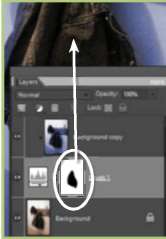
Step 3 >> Select the uppermost layer and select Layer > Group with Previous. Now select the layer mask and a black soft brush and paint the details from the layer beneath.
6.30 Color Variations based split toning
Suitable for Elements – 7.0, 6.0, 5.0, 4.0, 3.0, 2.0, 1.0 | Difficulty level – Intermediate | Resources – Web image 624 | Related Techniques – 6.28, 6.29 | Tools used – Brush | Menus used – Layer
The Color Balance feature in Photoshop provides a unique way of creating split tones. As the feature contains the ability to not only tint a grayscale image (that is in RGB Color mode), but also limit this tinting to one of three tonal ranges, shadows, midtones or highlights, it is the perfect tool for creating great split tones. The feature is also available as an Adjustment Layer meaning that split tones can be applied in Photoshop non-destructively.
Thankfully the Enhance > Adjust Color > Color Variations feature offers the same tinting abilities that are customized for specific tonal ranges. To start the toning process use the Convert to Black and White feature to change the color image to grayscale but still retain the RGB Color mode. Next open the Color Variations feature and target the Shadows, click onto one of the colored thumbnails a couple of times to add a tint to the shadows. Next choose the highlight setting and add a different color here. Hey presto! A split-toned print.

Step 1 >> Start by converting the color original to gray using the Convert to Black and White feature. This removes the color but maintains the RGB Color mode of the file allowing for the split toning later.

Step 2 >> Next open the Color Variations feature and target the Shadow areas. Click onto one of the color thumbnails a couple of times to tint the shadows.

Step 3 >> While the Color Variations dialog is still open, switch to the Highlight tonal range and tint these values a different color.
6.31 Photoshop’s Color Balance split toning in Elements
Suitable for Elements – 7.0, 6.0, 5.0, 4.0, 3.0, 2.0, 1.0 | Difficulty level – Intermediate | Resources – Web image 625 | Related Techniques – 6.16, 6.17 | Tools used – Brush | Menus used – Layer
For elements users who want to employ a non-distrutive workflow, the Color Balance adjustment layer from Photoshop can be dragged and dropped from a Photoshop document onto an Elements file. To keep the whole technique non-destructive a Photoshop Black and White adjustment layer should be used first to convert the image to grayscale. To help with this process I have created a Photoshop file containing a convert to gray layer and a range of split-tone options. To use, download the Photoshop-Split-Tones.psd file from the book’s website and open the document into Elements. Drag the Convert-to-Gray layer to the Elements file first and then add a split tone layer. Adjust the opacity of the split tone layer to control the strength of the split-tone colors.
Split toning >> Borrowing Color Balance and Black and White adjustment layers from Photoshop documents provides a way for Elements users to split tone non-destructively.

Step 1 >> Start by opening the Photoshop-Split-tone.psd file into the Elements editing workspace. Drag the Convert-to-Gray layer from the Photoshop document to an open Elements file.

Step 2 >> Now drag a split tone layer to the Elements document. If need be adjust the opacity of the layer to reduce the strength of the tinting colors.
Color and black and white >> By combining your selection skills, Elements’ masking options and the features of the Gradient Map adjustment layers you can create an image where black and white and color happily coexist.
Black and white and color
The same ‘two-layer erase back’ technique can be used for creating photographs which contain both color and black and white elements, but I prefer to use a different method based around Elements’ masking options.
6.32 Layer mask and gradient map
Suitable for Elements – 7.0, 6.0, 5.0, 4.0, 3.0, 2.0, 1.0 | Difficulty level – Intermediate | Resources – Web image 626 | Related Techniques – 6.18 | Tools used – Selection tools | Menus used – Select, Layer
With the color image open make a selection of the objects that will not be converted to black and white. In the example I used a combination of the Magnetic Lasso and the standard Lasso tools to select the three map pins, but you could also use the Magic Selection Brush to achieve the same results. Next, feather the selection (Select > Feather) slightly with a setting of 1 pixel to soften the edge of the effect. Invert the selection (Select > Inverse) so that the background (everything other than the map pins) is now selected. Then, with the selection still active, create a new Gradient Map adjustment layer (Layer > New Adjustment Layer > Gradient Map). When the Gradient Map dialog appears select the map with a smooth transition from black to white and click OK. Elements uses your selection to mask out the adjustment layer effects and restrict them from being applied to the originally selected map pins. You can create a multitude of other effects using the same process but different gradient maps or adjustment layers.

More effects >> You can create other effects using the same masking technique with the Threshold (a), Posterize (b) and Invert (c) Adjustment Layers options.
 Make sure that you save your selections (Select > Save Selection) as you make them. This way you can always reload them later if you need to.
Make sure that you save your selections (Select > Save Selection) as you make them. This way you can always reload them later if you need to.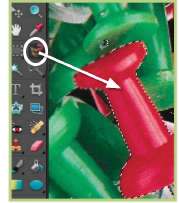
Step 1 >> Make a selection of the parts of the image that you want to remain in color.

Step 2 >> Feather the selection by 1 pixel and then Inverse the selectio
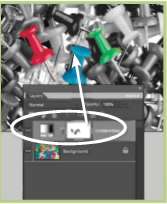
Step 3 >> With the selection still active create a new Gradient Map adjustment layer.
Border techniques
Creating a great border is one of those finishing touches that can really make your images stand apart from the crowd. Using Photoshop Elements you can easily create and apply a variety of different border styles to your photographs.
6.33 Simple borders
Suitable for Elements – 7.0, 6.0, 5.0, 4.0, 3.0, 2.0, 1.0 | Difficulty level – Intermediate | Resources – Web image 627 | Related Techniques – 6.34 | Tools used – Marquee | Menus used – Select, Window, Edit
A basic line border can be created by selecting the whole image (Select > Select All) and then stroking (Edit > Stroke) the selection on the inside with the foreground color. For fancier styles Elements provides a range of Frame and Edge treatments in its Artwork palette (Window > Effects). Some frames require you to make a selection first; others can be applied directly to the picture with no preliminary actions.

Stroked frame >> Use the Eyedropper tool to select a suitable border color from the image. Select all the picture (Select > Select All). Stroke the selection (Edit > Stroke Selection) on the inside with the foreground color and a width of 10 pixels

Layer Effects >> Display the Effects palette (Window > Effects) and then select the Special Effects > Photo Effects section. Choose frames from the drop-down list and then Drop Shadow from the thumbnails. Press the Apply button.
6.34 Sophisticated edges using grayscale masks
Suitable for Elements – 7.0, 6.0, 5.0, 4.0, 3.0, 2.0, 1.0 | Difficulty level – Intermediate | Resources – Web image 628 | Related techniques – 6.33 | Tools used – Paint Brush | Menus used – layer
You can create truly imaginative edges by using a grayscale mask to hide the edges of the picture. Start by using the Elements drawing tools to paint a black shape with rough edges on a white background. This is our grayscale mask. Ideally the dimensions of the painting should be the same as the picture to be framed. With both the picture and the mask open as separate documents, use the Move tool to drag the mask image on top of the picture. The mask will become a new layer. Use the Free Transform tool (Image > Transform > Free Transform) to scale the mask to fit the image precisely.

Grayscale mask borders >> You can use a grayscale mask to produce a creative border effect by stacking the mask on top and then changing the layer mode to Screen.
With the mask layer still active change the layer mode to Screen. This will cause the image from beneath to show through the black parts of the mask whilst the white areas of the mask hide the rest of the picture below.
This technique can also be used to create an image-filled border by inverting the mask before changing modes. This way the center of the picture is hidden by the white portion of the mask and the edges are filled with the image from below.
 Search the web for pre-made grayscale masks that can be downloaded and used directly in Elements.
Search the web for pre-made grayscale masks that can be downloaded and used directly in Elements.

Step 1 >> Create or download a grayscale mask. Open image and mask. Drag mask onto image as a new layer.

Step 2 >> With the mask layer selected use the Transformation tool (Image>Transform>Free Transform) to scale the mask to fit the image.

Step 3 >> Switch the mask layer’s mode to Screen to create the edge effect. To invert the effect select Image > Adjustments > Invert before changing the mode.
Picture edges >> More sophisticated masks of all manner of shapes, sizes and styles can be created using grayscale masks. By inverting the mask (Image > Adjustment > Invert) you can also create an edge filled with a picture rather than a picture surrounded by an edge.
6.35 Creating frames with Frame layers
Suitable for Elements – 7.0, 6.0, 5.0 | Difficulty level – Intermediate Resources – Web image 629 | Related techniques – 6.34 Tools used – Paint Brush Menus used – layer
Frame layers are brand new to Elements and have been introduced as part of the new system of creating multi-page themed documents (Photo or .PSE documents). Here, we will just take a quick look at the framing abilities of the new technology, but for a fuller description of how to create and edit PSE files go to Chapter 12.
Frame layers combine both the picture and the frame in a single layer. This a really cool aspect of this technology as it means that not only can the frame and layer combination be sized and rotated as a single composition, but the picture can also be manipulated independent of the frame. Photoshop Elements ships with a huge collection of frames that can be quickly and easily added to your pictures.
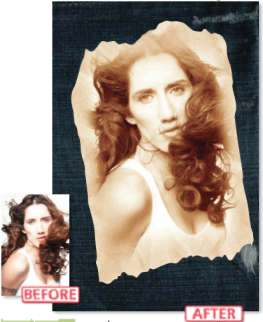
Frame layers >> Frame layers are a new way to dynamically add fancy borders to your photos.
The various designs are collated in the Content palette (under the Frames option in the By Type section of the palette). To add a frame to a picture that is already open in the Full Edit workspace display the palette first (Window > Content) and then click on the left-side drop-down menu and select By Type. Next choose the Frames option from the right-hand drop-down menu. After locating the frame type you want to add to your photo click on its thumbnail and then press the Apply button at the bottom of the palette.
Elements automatically creates a new Frame layer, adds your photo to it and then provides a small adjustment palette at the top of the framed image containing controls for sizing, rotating and replacing your photo. Alternatively, extra positioning and sizing options are available from the right-click menu. Click on the photo and then click-drag the corner handles to resize the frame and image together or the rotate handle to pivot the combination. Double-click the Move tool on the photo to select just the picture and use the handles to alter the photo independently of the frame.

Step 1 >> With a photo open in the editing space display the Frames section of the Content palette. Select the Frame Style thumbnail and click the Apply button.
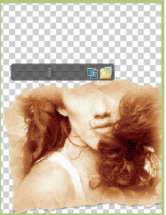
Step 2 >> Elements automatically creates a new Frame layer and places your photo in the frame design. Adjust the size and orientation of the picture using the pop-up adjustment palette.

Step 3 >> More picture controls are available from the right-click menu. In most cases the Fit Frame To Photo option should be selected first and then any fine-tuning added later.
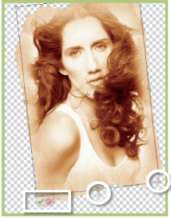
Step 4 >> Single-click the photo to select both frame and photo. Doubleclick to pick the photo only. Use the corner and rotate handles to fine-tune the size of picture and frame.

Step 5 >> To finish add a background to the composition by selecting the Background option from the right-hand menu. Next Choose the background and then click Apply.
Adding texture
Texture is a traditional photographic visual element that is often overlooked when working digitally. All but the highest quality professional films have visible grain when they are printed. This is especially true when the print size goes beyond the standard 6 x 4 inches. In fact we are so familiar with the idea that grain is part of the photographic process that putting a little texture into an otherwise grainless digital picture can lend a traditional ‘look and feel’ to the image.
Many photographers add a little texture to their pictures as part of their regular image editing process. Some go beyond this and produce photographs with huge clumps of grain that resemble the results often seen with prints made from old style high ISO films.
6.36 Add Noise filter
Suitable for Elements – 7.0, 6.0, 5.0, 4.0, 3.0, 2.0, 1.0 | Difficulty level – Intermediate | Resources – Web image 6.30 | Related techniques – 6.37, 6.38 | Menus used – Filter
The simplest method for adding texture to your picture is to use the Add Noise filter (Filter > Noise > Add Noise). The feature is provided with a preview dialog which allows you to alter the ‘Amount’ of noise that is added to the photograph, the style of noise – Gaussian or Uniform – and whether the noise is random colored pixels or just monochrome. As with most filters it is important to use this feature carefully as once the filter is applied and the file saved you will not be able to undo its effects. For this reason, it pays to make a duplicate file of your picture which you can texturize without risk of destroying the original image.
 Be sure to preview the image at least 100% when adding noise to ensure that the effect is not too strong. If in doubt, make a test print of sections of the picture with different Add Noise settings to preview the hard copy results.
Be sure to preview the image at least 100% when adding noise to ensure that the effect is not too strong. If in doubt, make a test print of sections of the picture with different Add Noise settings to preview the hard copy results.
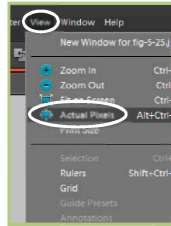
Step 1 >> Zoom in so that the picture is at least at 100% view or the Actual Pixels entry.

Step 2 >> Select the Add Noise filter from the Filter menu.

Step 3 >> Adjust the Amount slider to change the strength of the effect and pick the noise type and color.
6.37 Grain filter
Suitable for Elements – 7.0, 6.0,5.0, 4.0, 3.0, 2.0, 1.0 Difficulty level – Intermediate | Resources – Web image 630 | Related techniques – 6.36, 6.38 Menus used – Filter
As an alternative that provides a few more options than the technique above you can use the Grain filter (Filter > Texture > Grain) to add your choice of 10 different grain textures to your picture. Ranging from ‘regular’ through ‘horizontal’ to ‘speckle’ this filter produces a spectacular variety of texture effects. The feature’s dialog also provides an Intensity slider to govern the strength of the texture and a Contrast control.
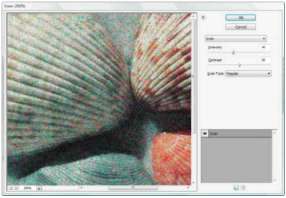
Adding grain >> The Grain dialog provides a preview thumbnail, Intensity and Contrast sliders and a selection of 10 different grain types.
The trick to creating good texture using this feature is the balancng of Intensity and Contrast settings. If the texture is too strong the shape and color of the original subject matter can be lost. If the contrast is too high then shadow and highlight details can be lost.
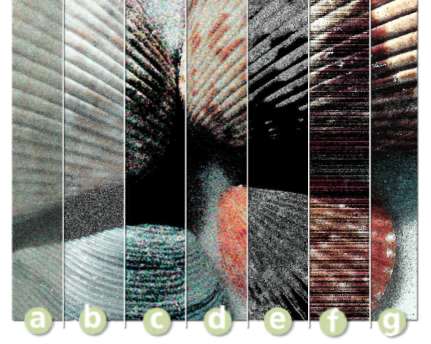
Texture options for the Grain filter >> The Grain filter provides a range of unique texture options that can be applied to your picture. (a) Regular. (b) Sprinkles. (c) Clumped. (d) Enlarged. (e) Stippled. (f) Horizontal. (g) Speckle.
6.38 Non-destructive textures
Suitable for Elements – 7.0, 6.0, 5.0, 4.0, 3.0, 2.0, 1.0 | Difficulty level – Intermediate | Resources – Web image 631 | Related techniques – 6.36, 6.37 | Menus used – Layer, Filter
As we have already seen adjustment layers are a great way to manipulate your pictures without actually altering the original image. This approach to image editing is referred to as ‘nondestructive’ as the integrity of the starting picture is always maintained. Mistakes or radical manipulations can always be reversed by switching off the adjustment layer leaving the untouched original below. Although there are no such things as Filter adjustment layers it would be handy to be able to use this same approach when making whole non-reversible image changes such as adding texture or noise to your pictures.
Such a technique was used in the following example. Despite the appearance of texture throughout the whole photograph the starting picture is still preserved at the bottom of the layer stack. To get the same results with your own pictures start by making a new layer (Layer > New > Layer) above the image. Next, fill this layer with 50% gray (Edit > Fill Layer) and Add Noise (Filter > Noise > Add Noise) to the layer. Change the mode of the gray textured layer to either Soft Light, Hard Light, Linear Light or Vivid Light. Notice how the texture is now applied to the picture. To soften the effect reduce the opacity of the texture layer.
Using this technique you not only preserve the integrity of the original picture but you can also alter the strength of the effect at any time. In addition, it is also a great way to apply the same amount and style of grain to several layers in a stack without having to individually select and filter each layer.
![]() To apply the same texture settings to a series of images of the same size simply drag and drop the gray texture layer into each of the open documents.
To apply the same texture settings to a series of images of the same size simply drag and drop the gray texture layer into each of the open documents.
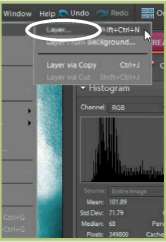
Step 1 >> Create a new layer above the image layer or background.
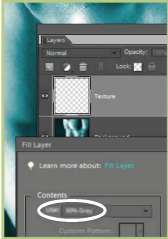
Step 2 >> Fill the layer with 50% gray using the Edit > Fill layer command.

Step 3 >> Texture the layer with Add Noise and switch the layer mode to Vivid Light.
Controllable texture >> By adding texture to a 50% gray layer above the image and then using the blending modes to apply the texture to the picture you can add grain to your picture non-destructively. Image courtesy of www.ablestock.com copyright 2005.
Advanced sharpening secrets
To most of us sharpening is a way of improving the clarity of photos using a single-click option such as Enhance > Auto Sharpen in Elements, but why should we relinquish control when it comes to this final step in the editing process? Here we look a little deeper at some of the more customizable options that allow the user to more easily match the sharpening effect with the subject matter and output destination of their photos.
Sharpening – What are the options?
Photoshop Elements provides a variety of sharpening options designed to increase the clarity of digital photographs. In previous versions these options were listed in the Filter > Sharpen menu and include the Sharpen, Sharpen Edges, Sharpen More and Unsharp Mask filters. In version 5.0 the options were moved and are now grouped under the Enhanc menu and include Auto Sharpen, Unsharp Mask and Adjust Sharpness filters.

Sharpen options >> Elements 5.0, 6.0 and 7 group the sharpening options under the Enhance menu. Unsharp Mask remains but the other filters have been replaced with the one-step Auto Sharpen and the sophisticated Adjust Sharpness options.
Digital sharpening techniques are based on increasing the contrast between adjacent pixels in the image. When viewed from a distance, this change makes the picture appear sharper or more defined. So applying a sharpening filter does not, and will never, make a poorly focused picture suddenly appear as if it has been focused correctly . Instead these filters are designed to make your photos appear more sharply defined.
For many users selecting an option such as the Auto Sharpen is about as far as they go when it comes to thinking about how to sharpen their pictures, but this ‘one-click’ filter fail to take into account the content of the photo and the intended use for the image – two factors that should deter mine the amount of sharpening you apply. So for the ultimate control of yours harpening use the advanced features in the new Adjust Sharpness filter, or the tried and tested Unsharp Mask filter. Both these options contain controls that allow the user to manipulate the strength of the sharpening effect and adjust which parts of the picture the filters are applied. Let’s look at each in turn.
6.39 Unsharp Masking to the rescue
Suitable for Elements – 7.0, 6.0, 5.0, 4.0, 3.0, 2.0, 1.0 | Difficulty level – Intermediate | Resources – Web image 632 | Related techniques – 6.40, 6.41 | Menus used – Enhance
Of the various sharpen filters that Photoshop Elements contains the Unsharp Mask provides some of the greatest control over the sharpening process by giving the user a range of sliders which, when adjusted, alter the way the effect is applied to pictures. Though a little confusing to start with, the Unsharp Mask filter is one of the best ways to make your scans or digital photographs clearer. However, to get the most out of the feature you must understand and control carefully each of the three sliders. So how does the feature work?

Step 1 >> Make sure that your picture is zoomed in or magnified to at least 100% before selecting the Unsharp Mask option from the Enhance menu. Select the Preview option in the dialog to ensure that the sharpening effects are shown on the full image.
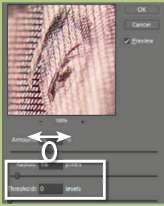
Step 2 >> Start with the radius set to 1 and the Threshold value adjusted to 0. Gradually move the Amount slider upwards watching the sharpening effect as you go. Stop when you find a setting where the picture appears clearer but contains no sharpening ‘halos’.

Step 3 >> To restrict the effect from being applied to skin tones, blue skies or other areas of smooth tone gradually increase the Threshold slider until the sharpening is just being applied to the picture’s edges.
The Amount slider controls the strength of the sharpening effect. Larger numbers will produce more pronounced results whereas smaller values will create more subtle effects. Values of 50% to 100% are suitable for low-resolution pictures whereas settings between 150% and 200% can be used on images with a higher resolution.
The Radius slider value determines the number of pixels around the edge that are affected by the sharpening. A low value only sharpens edge pixels. High settings can produce noticeable halo effects around your picture so start with a low value first. Typically values between 1 and 2 are used for high-resolution images, settings of 1 or less for screen images.
The Threshold slider is used to determine how different the pixels must be before they are considered an edge and therefore sharpened. A value of 0 will sharpen all the pixels in an image whereas a setting of 10 will only apply the effect to those areas that are different by at least 10 levels or more from their surrounding pixels. To ensure that no sharpening occurs in sky or skin tone areas set this value to 8 or more.

Unsharp Mask Top Tip:
Be careful when you are using the Unsharp Mask filter with your pictures. A little sharpening will improve the look of your photographs but too much sharpening is really noticeable and almost impossible to repair once applied to your picture. If you are unsure of your settings, apply the effect to a copy of the image first.

Adding clarity >> Careful sharpening can really add to the clarity of a digital photo, but like most enhancement techniques it is best to make such changes subtly. (a) No-sharpening. (b) After Unsharp Mask. (c) After Adjust Sharpness. (d) High Pass/Blend Light mode approach.
6.40 Adjust Sharpness for the ultimate control
Suitable for Elements – 7.0, 6.0, 5.0 | Difficulty level – Intermediate | Resources – Web image 632 Related techniques – 6.39, 6.41 | Menus used – Enhance
Until the release of Photoshop Elements 5.0 the best way to take control of the sharpening in your photographs was to use the Unsharp Mask filter. But the most recent release has included a brand new sharpening tool that will easily steal this crown. The Adjust Sharpness filter (Enhance > Adjust Sharpness) provides all the control that we are familiar with in the Unsharp Mask dialog plus better edge detection abilities, which leads to less apparent sharpening halos. The Filter dialog contains a zoomable preview, sliders to control the sharpening plus a drop-down menu where you can choose the type of sharpening to apply. You can control the sharpening effect with the following settings:
Amount – Strength of sharpening effect.
Radius – Determines the extent of sharpening. Higher values equal more obvious edge effects.
Remove – Determines sharpening algorithm used. Gaussian Blur uses the same approach as the Unsharp Mask filter. Lens Blur concentrates on sharpening details and produces results with fewer halos. Motion Blur reduces the effects of blur caused by camera shake or subject movement.
Angle – Sets Motion Blur direction.
More Refined – Longer processing for better results.
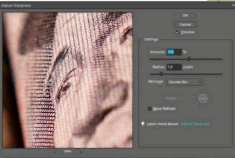
Adjust Sharpness >> The Adjust Sharpness feature introduced in Elements 5.0 extends the customized sharpening ability first started with the Unsharp Mask filter.

Step 1 >> Make sure that your picture is zoomed in or magnified to at least 100% and then select the Enhance > Adjust Sharpness filter. Select the Preview option in the dialogue to ensure that the sharpening effects are shown on the full image and also tick the More Refined option unless you are working with a large file or a slow computer.

Step 2 >> Choose the Lens Blur entry from the Remove menu. This option provides the best sharpening with least halo artifacts. Choose Gaussian Blur if you want to simulate Unsharp Mask results or Motion Blur if you are trying to get rid of the effects of camera shake.

Step 3 >> Start with the radius set to 1 and gradually move the Amount slider upwards watching the sharpening effect as you go. Stop when you find a setting where the picture appears clearer but contains no sharpening ‘halos’.
Adjust Sharpness Top Tip
One of the options for the new Adjust Sharpness filter is the Motion Blur entry in the Remove menu. The options listed in this menu determine the way in which sharpening is applied to the picture or more specifically, the algorithm used when filtering. The Motion Blur option is different to the other choices as it provides a method of reducing the effects of blur in a photo due to the camera or subject moving during the exposure. When Motion Blur is selected you have the added option of inputting an angle for the blur reducing action. This can be achieved with the dial control by click-dragging the mouse or by inputting a specific angle.

6.41 Another approach
Suitable for Elements – 7.0, 6.0, 5.0, 4.0, 3.0, 2.0, 1.0 | Difficulty level – Intermediate | Resources – Web image 632 | Related techniques – 6.39, 6.40 | Menus used – Layer, Filter
There is no getting away from the fact that sharpening photos with filters alters them irreversibly and forever. For this reason many photographers duplicate their precious pictures multiple times and apply different sharpening options to the copies depending on their intended use. This is not a bad approach, especially if you have plenty of storage space to hand, but what if you could sharpen your photos without altering the original pixels? Well surprisingly the Blending Modes feature located in Photoshop Elements provides the key to just such a technique. In particular, we will use the Hard Light Blend Mode in conjunction with the High Pass filter to create a non-destructive sharpening effect. The High Pass filter provides the mechanism for controlling where the sharpening occurs by isolating the edges in a picture and then converting the rest of the image to mid gray. This is perfect for use with Hard Light blend mode as the mid gray areas will not be affected at all and the sharpening changes will only be applied to the edges of the photo.

Step 1 >> Make a copy (Layer > Duplicate Layer) of the picture layer that you want to sharpen. Filter the copied layer with the High Pass filter (Filter > Other > High Pass) and press OK.

Step 2 >> With the filtered layer still selected switch the blend mode to Hard Light. This mode blends both the dark and light parts of the filtered layer with the picture layer, causing an increase in contrast.

Step 3 >> Adjust the opacity of this layer to govern the level of sharpening. Sharpening using this technique means that you can remove or adjust the strength of the effect later by manipulating the filtered layer.




